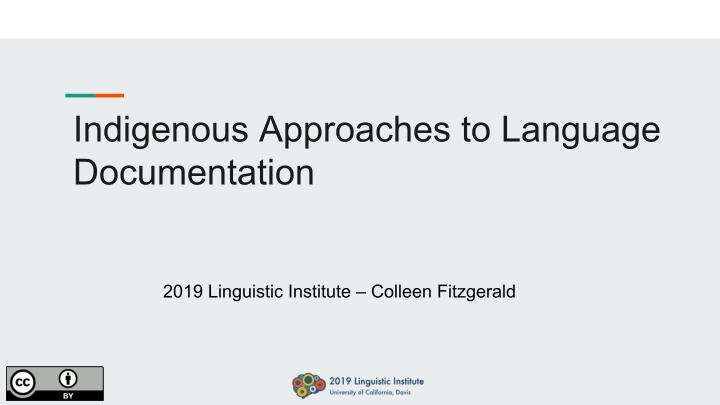



Indigenous Approaches to Language Documentation 2019 Linguistic Institute – Colleen Fitzgerald
Organization ● Class discussion of the readings ● Some indigenous-driven software ○ Miromaa ○ Murkurtu ○ ILDA ● Intellectual Property and TK rights ● Repatriation and stewardship
Class Discussion of the Readings
● Indigenous Data Sovereignty: Data for Governance: Governance of Data Advancing the ethics of Paleogenomics ● Miromaa packet ●
Miromaa
Miromaa https://www.miromaa.org.au/ “ developed by Aboriginal people for Aboriginal people” (from Your Language Journey p. 8)
What is Miromaa? Licensed software, used extensively in Australian indigenous communities as ● well as in some U.S. indigenous communities Creates a digital library in one place of your language materials, including audio ● (integrates with Audacity), video, documents, maps, photos, books, and wordlists. Can use those to create picture dictionaries, apps with language materials, for ● example Allows users to set protocols which allow or restrict access based on traditional ● community norms for usage
Pros vs. Cons Strongly grounded in the guiding Proprietary and requires the purchase ● ● principles for why indigenous of a software license communities often do language work The software serves as a place which ● (reclamation) allows management of many kinds of Reflects local knowledge and use of materials, but is different from a ● protocols – not all people should have DELAMAN archive in terms of access to all (kinds of) knowledge sustainability of digital resources. Assigns and allows management of roles (Designed for community members, not ● ● of team members necessarily linguists) Designed for community members, not ● necessarily linguists
Mukurtu
Mukurtu – a content management system (CMS) “The word “mukurtu” in Warumungu means “dilly bag.” Dilly bags hold sacred ● items and are accessible by acting responsibly within the community and gaining the permission of knowledgeable community leaders. Like the dilly bag the archive is a “safe keeping place,” a community repository for cultural materials and knowledge that grows from continued use, dialogue and negotiations. The Warumungu community maintains the original archive at the Nynikka Nyunyu Art and Culture Centre where people access their materials, deposit new content, add knowledge and information to existing content, and create new materials.” http://support.mukurtu.org/customer/en/portal/articles/1305304-what-does- ● mukurtu-mean-
What does Mukurtu do? Mukurtu (mukurtu.org) focuses on management of indigenous cultural heritage ● and is used by many indigenous libraries, museums and archives: ● “Mukurtu is the only CMS that provides: ○ Customizable, granular cultural protocol-driven access to digital content based on local knowledge systems; ○ Pathways for sharing content and metadata between multiple community groups within the platform; ○ Layered narratives and curation for materials that go beyond the "item" level to connect content, metadata, traditional knowledge and cultural narratives in one view; ○ Flexible and clear licensing and labeling of content; and ○ Selective metadata transfer between collecting institutions and Indigenous communities using Mukurtu's "roundtrip" feature. “ From https://doi.org/10.1045/may2017-christen Christen et al. 2017 ○
https://youtu.be/jpIZjIO1rkU
Pros vs. Cons free and open source platform The software serves as a place which ● ● developed with and for Indigenous allows management of many kinds of communities. materials, but is different from a Reflects local knowledge and use of DELAMAN archive in terms of ● protocols – not all people should have sustainability of digital resources. access to all (kinds of) knowledge Not designed specifically for language ● Assigns and allows management of roles work ● of team members Not designed specifically for language ● Inadequate for storing large video files work. ● Not designed specifically for language ● work.
TK Labels: a way to add local protocols http://localcontexts.org/tk-labels/ “an educative and informational strategy to help non-community users of ● traditional cultural knowledge understand the importance and significance of this material, even when it is in the public domain and appears within an institutional catalogue as though it can be shared and used by everyone. The TK Labels are designed to identify and clarify which material has community - specific protocols of access and use associated with them…their proper use, guidelines for action or responsible stewardship.” P. 2, Background Brief on Local Contexts and the TK Labels , ○ http://localcontexts.mukurtu.org/wp-content/uploads/2016/12/Local-Contexts- Background-Brief.pdf
Giving fine-grained detail to collections… “…I think the other thing that we see particularly in dealing with colonial ● collections is that they do still cause trauma.” https://podtail.com/podcast/trust-me-i-m-an-expert/mukurtu-an-online-dilly- ● bag-for-keeping-indigenous/
Indigenous Languages Digital Archive (ILDA)
ILDA Miami-Illinois Digital Archive – “a digital archival database that met the needs ● of both tribal linguists and community culture and language revitalizationists”: Baldwin, Daryl, David J. Costa & Douglas Troy. 2016. Myaamiaataweenki ○ eekincikoonihkiinki eeyoonki aapisaataweenki: A Miami Language Digital Tool for Language Reclamation. Language Documentation & Conservation 10. 394-410. https://scholarspace.manoa.hawaii.edu/handle/10125/24713 Demo (sort of) ● https://ildarchive.org/nuuweeya/index.php?group=nuuweeya ○
Intellectual Property Rights
World Intellectual Property Organization (https://www.wipo.int) "Intellectual property protects creations of the human mind, including trade ● secrets, literary and artistic works, inventions, designs and symbols, and names and images used in commerce." "Traditional knowledge (TK) is generally understood to mean the know-how, ● skills, innovations and practices developed by indigenous peoples and local communities, while traditional cultural expressions (TCEs) are generally understood as the tangible and intangible forms in which traditional knowledge and cultures are expressed. 3 " "the knowledge that indigenous peoples and local communities have developed ● regarding the use of plants for medicinal purposes is TK, while traditional dances, songs and designs are TCEs. Traditional handicrafts may embody both TK (the method of making) and TCEs (their external appearance)." (Page 9, Protect and Promote Your Culture: A Practical Guide to Intellectual Property for Indigenous Peoples and Local Communities ) https://www.wipo.int/publications/en/details.jsp?id=4195
More resources http://localcontexts.org/educational-resources/publications ● CoLang 2016 Course on IP ● https://drive.google.com/open?id=0BzIdfqwXyAYDbkJrc1ktQXVNdGc https://www.wipo.int/tk/en/indigenous/ ●
Community Consultant
Food for thought…Native American Graves Protection and Repatriation Act (1990) The NAGPRA Comics: https://nagpracomics.weebly.com/ by Sonya Atalay, Jen ● Shannon, and John Swogger Next 3 slides are taken NAGPRA Comics 1 ● https://nagpracomics.weebly.com/the-comics.html
Recommend
More recommend